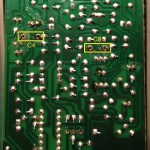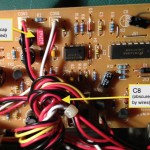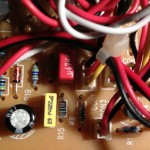Difficulty: Simple
This one is a quite easy mod, since the pedal itself is nearly perfect for fattening up a bass. in stock form it does roll off some of the low end, though (it is a guitar compressor, after all), so that bit needs fixing. Another problem with the ED-1 is the bypass system – if you plug a passive bass (no active electronics) straight into it, the bypass tone will be quite severely compromised. As long as the pedal is kept on, though, or if there’s something active (a buffered pedal or tuner) in front of it, or if you’re using active pickups or a preamp in the bass itself, everything is ok. I’ll go into more detail about this later, but first let’s deal with getting the compressor itself to work for bass.
The mod
This bit is dead simple. To get the bottom plate off, just open the battery compartment and remove the four screws that hold the bottom plate in place. From there, the circuit board can be lifted out. The wires to/from the main board are twisted together, so if you rotate the board you’ll get more room to work. Don’t disconnect the wires – even though they hook up with simple connectors, remembering which goes where and in which direction is tricky, and you’ll have plenty of room anyway.
Once you’re inside the pedal, you need to locate and replace two capacitors. See the image above right for the component locations on the back of the board.
The two capacitors are (stock value in parenthesis):
- C4 (0.01uF/103) -> 0.22uF /224
- C8 (0.047uF/473) -> 0.47uF/474
C8 can be a little tricky to get at, since it’s located right in the maze of wires, but it is definitely doable. The wire bundle is created by spinning the whole board around, basically twisting the wires into a knot. So rotating the board too loosen the knot really helps. Make sure you desolder both capacitors properly, so they are fully loose, before you turn the board around and try removing them. This is especially important with C8, due to it being partly hidden by wires.
The pic above shows an overview, and to the right a closeup of C8 (it’s the big red capacitor, in case you’re wondering). The circuit board has component labels, so once you get through the maze of wires, you will find it. Once you’ve replaced the two capacitors, rotate the circuit board so the wires twist together again, and reassemble the pedal.
About the sound
The pedal – even after the mod – does roll off a little treble as it is compressing, which can make it a little dull on guitar. But for bass, that works out great. Usually if I set the bass rig up for a fairly neutral sound, the sharp finger noise coming through highlights any sloppiness in the playing, making me sound like the bass newbie I really am. I’ve never really understood how bass players make that work, but I’ve come to accept that it’s simply in the fingers. It’s the old ”tone is in the fingers” thing… But this pedal actually makes me sound like a far better bass player than I am, so I’m happy 🙂
One thing to note, though. I’ve noticed that too strong input signals (for instance from hot pickups) can cause it to distort. It’s actually something I’ve mostly noticed when playing (humbucker-equipped) guitar. I haven’t heard it when playing bass, but if your bass has fairly high output pickups, this pedal might not be for you.
What about the bypass bit?
As I mentioned at the beginning, the bypass system is not very transparent. The Marshall designers added a few inductors and ferrite beads to the input of the pedal, which have a distinct impact on the tone (especially in the midrange) when you plug a passive bass straight into the pedal. I’ve tried modifying the pedal to true bypass, removing all those extra bits, and that fixed the problem. But… it also meant the pedal produces a distinct ”pop” every time you step on it, and none of the usual tricks (pulldown resistors etc) seems to cure the pops. I even tried disconnecting the LED, to see if the rush of current when it turns on was the cause, but to no avail. I guess the inductors and ferrite beads were put there for a reason – if I wanted to be just a tad mean, I’d say it was to hide what is inherently a bad circuit layout. Something in the core layout is too close to something else, and only a complete circuit redesign would cure the problem. But what do I know? 🙂 Anyway, I’ve left mine in its true bypass form, but if I were to do another, I’d leave the bypass bit stock. Keeping a buffered pedal in front of it (which I have on my main guitar pedalboard) makes the bypass a non-issue, and when I use it on bass I never turn it off anyway… 😀


